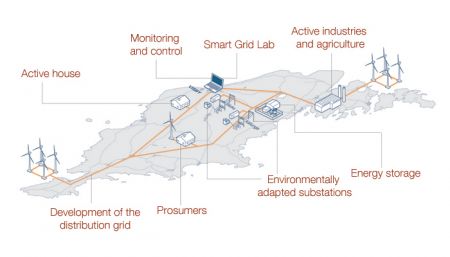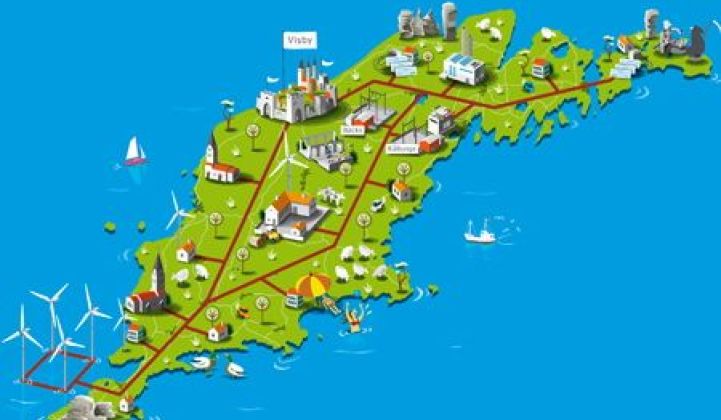One of the great debates in the utility field is exactly how much intermittent wind and solar power is too much for the grid to handle, and what new technologies are needed to raise that ceiling. The smaller and more isolated the grid, the more quickly these once-theoretical barriers are being breached, making islands like Hawaii and Puerto Rico early test beds for the challenges of double-digit percentage rates of wind and solar penetration.
Gotland is another island challenged by the future it’s staking on green power. The Swedish Baltic Sea island’s 57,200 residents got about 38 percent of their electricity from 183 megawatts of locally produced wind power as of 2011, a remarkably high level of penetration. The island’s two high-voltage direct current links to the mainland have helped keep that balance as well.
But there are limits to Gotland’s green ambitions. The island’s utility, Gotlands Energi AB (GEAB) can’t handle more than 195 megawatts or so of wind power in its present grid formation. Raising that limit is the challenge of Smart Grid Gotland, a consortium including GEAB, its owner Vattenfall, and companies including ABB, Schneider Electric and Echelon.
Since 2012, the partners have been smart metering the island, installing sensors and load control devices at residential and commercial buildings, and instrumenting the island’s grid, all with an eye toward balancing the ups and downs of wind power with locally addressable energy demand.
The goal isn’t just local balance, edging out diesel fuel costs and improving sustainability, as with many other island grids. Sweden has set a goal of getting half its electricity from green resources by decade’s end, making Gotland’s lessons worth translating to a larger grid context, said Clinton Davis, vice president of industry solutions for Ventyx, the software arm of grid giant ABB.
Ventyx just announced its participation in Smart Grid Gotland, with plans to integrate the island’s various systems into a “Distribution System Optimization solution” that includes grid control, demand response and forecasting and business analytics. Think of it as the place where local grid stability, customer energy management and utility-scale electricity trading come together to address the wind power challenge.

“This is all about the integration of renewables, to allow folks connected to the wind farms there to have programs for demand response that would help them balance the network,” he said. Traditional demand response -- shutting down equipment or turning down air conditioners to reduce peak demand -- doesn’t operate with the flexibility or speed to address momentary ebbs and surges in wind, or how those changes in generation ripple through a complex electricity distribution system.
“A lot of it is based on forecasting the wind and load and prices, and making analyses of the variable demand response capacity available,” he explained. Half the battle is knowing in advance how much customer flexibility is out there on the system, in terms of willingness to alter heating and cooling patterns or turn off nonessential equipment at a moment's notice.
Wind farms have certain ramp rates and minimum generation thresholds they have to meet, but beyond that, they’re largely inflexible, making “one of the challenges matching the demand with the wind,” he said. That’s a common feature of renewable integration projects that tap energy demand as a resource, such as the PowerShift Atlantic project in Canada’s Maritime provinces. Emerging standards like OpenADR are making real-time demand management a more attractive proposition for many building owners and system integrators.
As for what to call this collection of demand-side resource, “we still use the term 'virtual power plant,' because we think it’s useful,” he said. The idea is to manage 10,000 home heaters as one large combined heat and power plant, in terms of its ability to match wind power fluctuations in cost-effective ways. Ventyx is working with a mix of industrial and commercial sites, as well as with residents -- or as the consortium likes to call them, "prosumers" -- to enable them to receive grid alerts, price messages and other data points needed to act in concert with the system.
Ventyx is combining ABB’s volt/VAR optimization (VVO) solution into the mix to address the over- and under-voltage issues that can arise with ebbs and flows of wind power onto the grid, he added. “We’re also starting to learn the impacts of running volt/VAR optimization on top of demand response” -- in other words, making sure that system-ordered changes in customer energy consumption don’t have unintended consequences on grid voltages being managed by a separate VVO platform, or vice versa.
Ventyx is already involved in managing Sweden’s high-voltage power grid along similar lines, through a project it launched last year with German utility E.ON. “They were doing some work around demand response and distributed energy resource management, as well as network optimization using our volt/VAR algorithm to stave off what demand they could to reduce their transmission constraints,” he said.
That platform went live recently, and E.ON is now using it as “sort of a predictive tool alongside their normal day-to-day operations,” he said. Merging the transmission grid and energy market side of the utility with the local, distributed, customer-facing side of things is the next challenge, he said. Ventyx just announced a partnership with Swedish utility Fortum at the Stockholm Royal Seaport smart grid test bed, which will incorporate local demand response, ship-to-shore power and local grid controls in a way that’s fully integrated with the grid at large.



